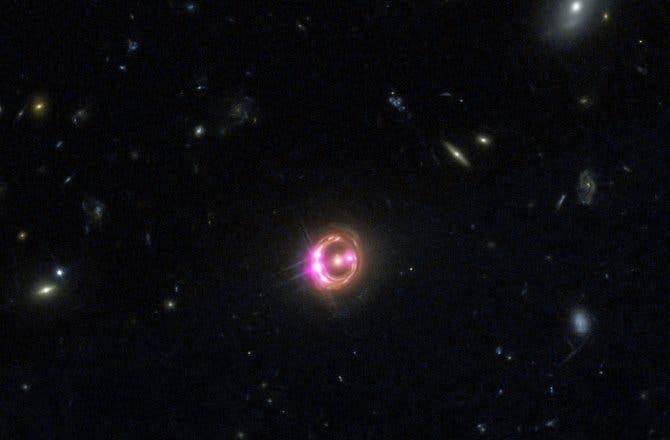
About half of the Universe’s lifetime ago, it was feasting time for supermassive black holes – they were eating galaxies left and right, a new study might suggest. Taking advantage of a galaxy which acts like a natural zoom lens in space, astronomers have analyzed a black hole powering a quasar about 6 billion light years from Earth.
“The ‘lens’ galaxy acts like a natural telescope, magnifying the light from the faraway quasar,” University of Michigan astronomer Rubens Reis explains in a paper published in this week’s Nature.
Quasars and black holes
Quasars are amazing things! They are the most energetic and distant members of a class of objects called active galactic nuclei (AGN). The general consensus now (while there is still some debate) is that quasars are compact regions surrounding the supermassive black holes at the center of some galaxies. More than 200,000 quasars are known.
Analyzing four magnified images created by the lens galaxy, astronomers found that the quasar’s black hole is spinning at half the speed of light.
When it comes to black holes spinning, it’s all about the “feeding”. Black holes of course are so massive that they attract and “devour” anything – even light can’t escape from them, that’s why they’re black. The thing is, the more they eat, the faster they spin – so a black hole that’s been destroying lots of stuff would be spinning really fast. How fast? Let’s say half the speed of light fast.
“If the mass accretion was more messy it would suggest that the black hole would have a lower spin,” astronomer Mark Reynolds, also with University of Michigan, explained.” What we found in this system is that it’s spinning very rapidly,” Reynolds said, consuming mass equivalent to about one sun per year.
Just so you can get a sens of the scale we’re discussing here, we’re not talking about eating a planet or two – we’re talking about eating an entire galaxy, or perhaps even more. Astronomers believe that the black hole probably accumulated two galaxies colliding with each other, conveniently funneling the resulting gas and matter.
“This is the first time that we’ve been able to push out to this type of distance by using the gravitational lensing effect. We hope … to carry out similar studies on other (more distant) galaxies. Then we can begin to really start relating the black hole to the actual galaxy it’s in, how many mergers happened and things like that,” Reynolds said.
It’s still not clear if this kind of thing is common, or if researchers stumbled upon an exception.
“Different theories of galaxy evolution predict a different rate of mergers, and a different process of gas inflow into the center of galaxies,” Guido Risaliti, with the INAF Arcetri Astrophysical Observatory in Florence, Italy, wrote in an email to Discovery News. “These processes, in turn, determine the final black hole spin. So knowing the distribution of supermassive black hole spins is a way to constrain the way they were formed, and so, ultimately, the way their host galaxies formed and evolved,” Risaliti wrote.






